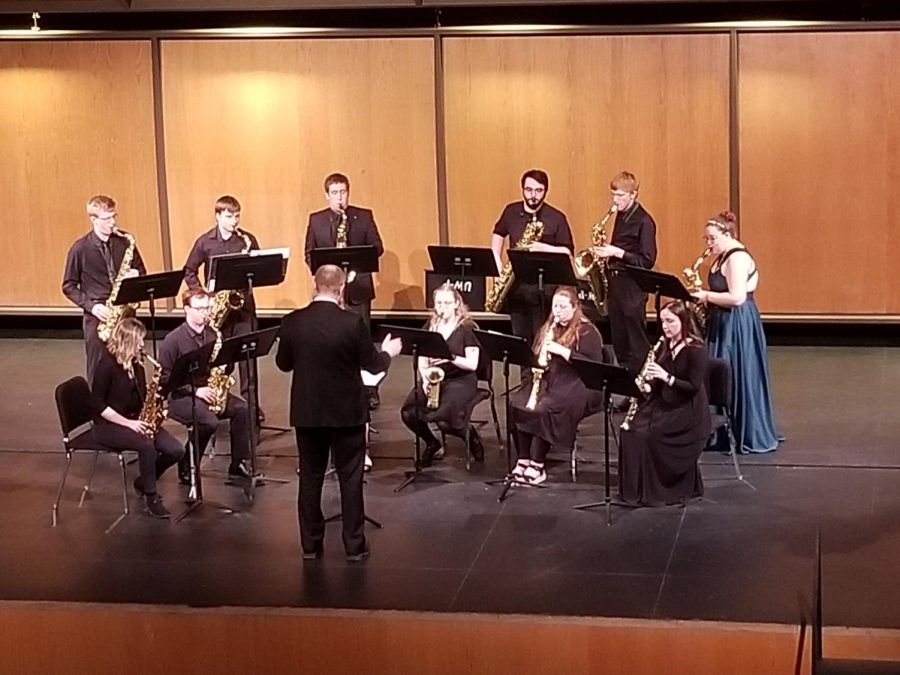Saxophone Senior Recital
The Center for the Arts showcased the musical expertise of senior Music Education Major Marissa Mueller on May 7 at 7:30 p.m. in Brodbeck Concert Hall.
Mueller performed with pianist Rob Shepherd and percussionist Jordan Larson-Sell on marimba, and played as part of the Le Reve Saxophone Quartet, part of the UW-Platteville Saxophone choir and as a soloist.
Mueller graced the audience with an emerald green gown, a diamond headband and a large tenor saxophone. The first piece, “Diversion,” was played with piano accompanist Rob Shepherd. Mueller played light and airy as Shepherd played charming minor chords. Mueller’s saxophone answered the piano with full arpeggios that embodied anticipation. Mueller’s well-developed technique of air control allowed the saxophone to fade into the piano.
Mueller showcased a large range of skills with distinct uses of pianissimo and crescendos, trills and swells which often helped sneak the saxophone back into the piece.
During the solo moments, Mueller set a completely different mood. As “Diversion” slowed down, Mueller took advantage of creating an individual pace to fill the theater with varying dynamic arrangements. This created an easy transition into the next piece in which Mueller played as a soloist.
In “Sonata in A Minor,” Mueller began the piece with a bellowing low note which was quickly replied to with higher-toned arpeggios. Mueller’s arpeggios fluctuated in both speed and volume. The piece’s diversity in tone transformed into dreadful and romantically complex.
Rob Shepherd accompanied Mueller on piano once more for “Sonata for Tenor Saxophone.” Mueller spritely played with sharp timing. The latter half of the piece had Mueller switch between octaves every other note with impressive speed and accuracy.
The tone was developed by Mueller’s staccatos as they jutted into Shepherd’s melodic yet discordant piano chords. Mueller’s saxophone blended at pianissimo and swelled into a strong presence over the piano. Mueller delegated the piece’s tone with certainty as required by the demanding changes and dynamic transitions.
In the second half of the concert, Mueller was accompanied by Jordan Larson-Sell, a second-year music education major, on marimba for “Escape: III. Cortex, IV. Escape.” Larson-Sell’s dashing black suit with an emerald-green tie accentuated Mueller’s emerald-green gown.
Larson-Sell’s marimba harmonized quickly and repetitively played four-note chords, two notes on each hand. Mueller played arpeggios melodically alongside the consistently sustained marimba.
Additionally, Mueller played as one-fourth of the Le Reve Saxophone Quartet, which was made up of a soprano saxophone, two alto saxophones and one larger style of saxophone. The range in distinctly different saxophones gave “Grave Et Presto” a diversified and well-layered quality. Each saxophonist’s individual part stood out from the others as they each sustained notes at different times. Then the quartet began playing lightly and quickly.
Mueller played voluminous booming tones which struck the other saxophonists’ quieter notes with urgency. Mueller showcased quick repetitive arpeggios as the other three saxophonists played melodically alongside like accompanists. The Le Reve Saxophone Quartet performed with consistent accuracy and a well-balanced sound.
After the quartet played, Director of Jazz Studies Allen Cordingley said, “The reason that quartet, that played so well, is even playing together is because Marissa wanted that group to be together. She got all the music. She scheduled the rehearsal and she does everything for everybody, and we’re going to be so proud whenever she goes out and does that for her students.”
Cordingley directed the UW-Platteville Saxophone Choir for the final two pieces. Cordingley said “Three Images: II. Golden Hour” is a meditation on the image of the sun setting or rising. Cordingley encouraged the audience to think of loved ones lost, who might also see the golden hue with us.
The piece began with separate groups of saxophonists coming in one after another, which created the most natural swell in sound. Then the saxophones transitioned into the next section at separate times with trills, alternating notes and arpeggios. The piece embodied glory, similar to the feeling of being human while watching the sunrise or sunset.
Percussionists joined the UW-Platteville Saxophone Choir for the final piece, “Symphony No. 4: Finale.” The fanfare opened with a slam of the cymbal crash and bass drum. Arpeggios were joyous and energetic. The ringing of a delicate triangle transitioned the piece into its romantic section when larger saxophones swelled and played heavy staccatos. The smaller saxophones played light staccatos until the abrupt and final chord.
Cordingley reflected on Mueller’s years of practice and said, “I can’t believe it’s already been ten years. She’s playing her senior recital, and I think I’ve learned as much from her as hopefully she’s learned from me.”




